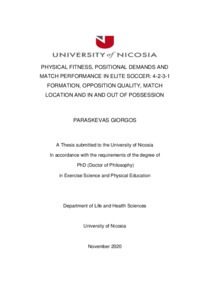- Paraskevas, Giorgos
- School of Sciences and Engineering |
- Department of Life and Health Sciences
- 2021
- English
- 125 pages
- Hadjicharalambous, Marios | Smilios, Ilias | Terzis, Gerasimos
- Magnitude Based Inferences | Smallest Worthwhile Change | Biological Variability | Fixture Congestion | Submaximal Endurance | Soccer | Training Load | Specific Fitness Training | High Intensity Running | Sprinting | Fitness Training | Aerobic Capacity | Variability
- Sciences and Engineering -- Life and Health Science
-
-
The purpose of this thesis was to identify individual response patterns in selected aerobic fitness variables of regular starters and non-starters, examine the influence of match location, quality of opposition team, and playing position as well as phase of the game (in and out of possession), on physical performance indicators of the 4-2-3-1 formation in elite soccer players. Professional soccer players (29.5±4.0 years) were tested were tested for maximal oxygen uptake (VO2max), velocity at 4 mM of lactate (V4), velocity at maximal oxygen uptake (vVO2max) and oxygen pulse (O2-pulse) in July and December following consecutive periods of fixture congestion. In addition twenty-six games were recorded with a video system and players (27±4.0 years) were analyzed according to their playing position for total distance (TD), high-intensity running (HIR), very-high-intensity running (VHIR), sprinting (SPR), number of VHIR activities (nVHIR) and average distance during VHIR (aVHIRd). V4 was the only variable that increased significantly in December compared to July (15.1 ± 0.5 vs. 14.6 ± 0.5, p = 0.001) with an almost certain beneficial large mean team change (ES = 1.2 (0.67; 1.57), 100/0/0). With the exception of V4 where 10/17 players showed positive changes higher than the biological variability, all other variables were characterized by a substantial proportion of changes lower than the biological variability. Wide defenders covered the most SPR and -along with the central midfielders- the most VHIR. Central midfielders covered the most TD and HIR. Match location and opposition quality had interactive effects on TD (F=12.96, p<0.001), HIR (F=8.33 p=0.004) and VHIR (F=8.17 p=0.005). Phase of the game impacted on positional physical demands. WD covered more VHIR; CM covered more VHIR and sprinting; and CD covered more VHIR, executed more nVHIR and had longer aVHIRd out compared to in possession (P<0.05). In possession CM covered more TD and WM covered more TD, VHIR and sprinting and executed more nVHIR compared to out of possession (P<0.05). WD, WM and FW covered more sprinting and had longer aVHIRd compared to CD and CM (P<0.05). Submaximal aerobic fitness variables appear to be more informative in the physiological evaluation of top-level soccer players and this may be an advantage during exposure to periods of consecutive games. WD are highly taxed both in and out of possession. However, WM and FW are taxed only in possession, while CD and CM are mainly taxed only out of possession. In addition, our results suggest more intense-based drills (e.g., repeated sprint training) for wide defenders and more volume-based drills (e.g., long interval training) for central midfielders, whilst total weekly training load can be adjusted based on match location and quality of oppositions on the anticipated game-load.
-
Physical fitness, positional demands and match performance in elite soccer: 4-2-3-1 formation, opposition quality, match location and in and out of possession
| Type | Location | Link |
|---|---|---|
| dissertation | [More information] |

